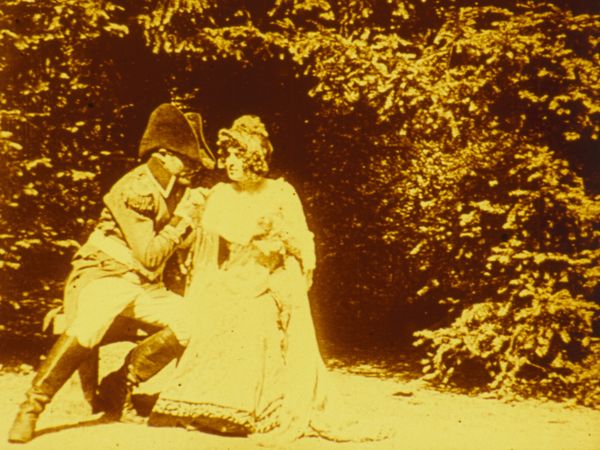LA GRANDE BRETÈCHE
(Inmurad)
André Calmettes (FR 1909)
Perhaps it’s no surprise that the French version of “La Grande Bretèche” takes a less censorious approach to the adulterous couple than either the Italian or American versions. Adapted by playwright Paul Gavault, who’d been hired by Pathé’s Film d’Art division in the summer of 1909, the film is truer to Balzac’s conception, though as Moving Picture World (11 December 1909) noted on its U.S. release (under the French title), in the short story the wife (Véra Sergine) doesn’t give herself or her lover away. Of course things end gruesomely for the poor Spanish officer (Philippe Garnier), and the disturbing finale captures his agony as he expires in his walled-up chamber.
The goals of Film d’Art in putting classic literary works on screen have been too well-covered to detail here. Director André Calmettes, who also plays jealous Monsieur de Merret, was responsible, together with Charles Le Bargy, for the ground-breaking L’Assassinat du duc de Guise (1908), a film that D. W. Griffith acknowledged as a major influence (in A Companion to D. W. Griffith, Charles O’Brien suggests that the staging of The Sealed Room is indebted to L’Assassinat). In keeping with Pathé’s aspirations towards prestige, the actors selected were taken from the top theatre companies: Garnier from the Comédie-Française, Sergine from the Odéon, and Calmettes himself was with the Gymnase and Odéon (an interesting aside: Sergine was married to Jean Renoir’s brother Pierre, and is said to have introduced the budding director to the French theatre scene; her son Claude was the noted cinematographer).
La Grande Bretèche was such a success at home that it was reissued in March 1916, with Hebdo-Film (4 March 1916) praising the mise-en-scène, notwithstanding the film’s age. Its popularity in Germany, where it was released under the title Eingemauert, was so great that there too it was reissued, also in 1916, at the height of the War. Reviews in the U.S. press were also strong, though curiously I’ve been unable to find anyone making a comparison between the Pathé film and either the Biograph or the Vitagraph, despite the proximity of their releases.
Jay Weissberg

regia/dir: André Calmettes.
scen: Paul Gavault, dal racconto di/based on the short story by Honoré de Balzac (1831).
cast: Véra Sergine (Mme. de Merret), Philippe Garnier (Comte de Férédia), André Calmettes (M. de Merret).
prod: Les Films d’Art, Pathé Frères (no. 3177).
uscita/rel: 22.10.1909 (Pathé Grolée, Lyon).
copia/copy: 35mm, 164 m. (orig. 290 m.), 9′ (16 fps), col. (imbibito/tinted); did./titles: SWE.
fonte/source: Svenska Filminstitutet, Stockholm.


 Italiano
Italiano